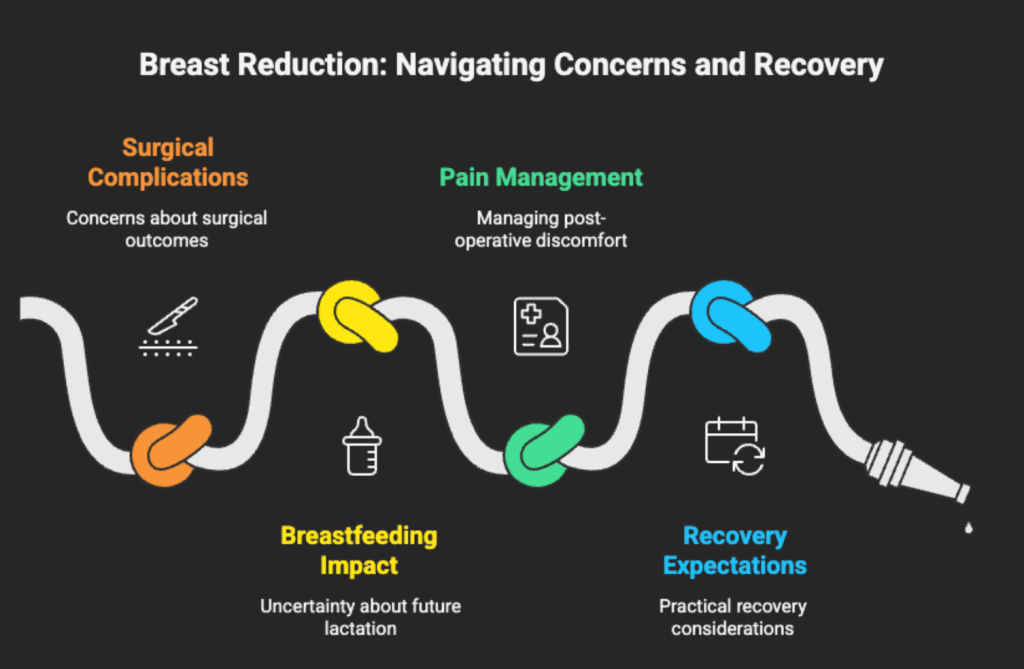Breast reduction surgery, or reduction mammoplasty, is a life-changing procedure for women struggling with overly large or heavy breasts. Beyond aesthetics, it addresses real health concerns—chronic back and neck pain, skin rashes, shoulder grooves, and even emotional stress.
But before you decide, it’s natural to wonder: What really happens during breast reduction surgery? Will it affect breastfeeding? Is the recovery painful?
As someone considering this transformation, you deserve clear, expert-backed information. This guide—written for women exploring breast reduction in India—covers everything you need to know, with insights from Dr. Sumit Malhotra, a leading plastic and cosmetic surgeon based in Lucknow, India.
What Really Happens During Breast Reduction Surgery
A breast reduction isn’t just about size—it’s about sculpting, lifting, and harmonizing your breasts with your body.
Here’s a step-by-step outline:
- Pre-Surgery Consultation
Dr. Malhotra begins with a detailed evaluation: your health history, breast size, nipple placement, skin quality, and expectations. Photographs and precise measurements are taken to plan your personalized procedure. - Anesthesia
The surgery is performed under general anesthesia for complete comfort. - Incision & Reshaping
Depending on your needs, an incision (anchor, lollipop, or vertical) is made. Excess tissue, fat, and skin are removed. - Nipple Repositioning
The nipple-areola complex is carefully repositioned higher on the breast for a natural, youthful contour. - Sutures & Healing
Internal sutures support your new shape, and bandages or compression garments are applied.
On average, the procedure takes 3–5 hours. Most women return home in 1–2 days, with supportive aftercare instructions.
Who Should (and Shouldn’t) Consider It
Not every patient is the same. According to Dr. Sumit Malhotra, the right candidate is one who is both physically and emotionally prepared.
✅ Ideal Candidates:
- Women with constant back, shoulder, or neck pain due to heavy breasts
- Those with posture problems or deep grooves from bra straps
- Women with skin irritation under the breasts
- Patients struggling with self-esteem issues linked to breast size
- Non-smokers in overall good health
❌ Those Who Should Delay or Avoid Surgery:
- Women planning pregnancy soon, since changes may alter results
- Smokers unwilling to quit before and after surgery (it delays healing)
- Patients with unmanaged medical conditions such as diabetes or heart disease
- Adolescents whose breast growth isn’t complete
Will It Ruin Your Ability to Breastfeed?
One of the biggest concerns women share with Dr. Malhotra is: Will I still be able to breastfeed?
Here’s the truth:
- Modern surgical techniques prioritize preserving milk ducts and glandular tissue. This means many women can successfully breastfeed after breast reduction.
- In rare cases where the nipple must be repositioned extensively, milk supply may be affected.
Dr. Malhotra’s approach: He uses methods that carefully protect the structures needed for breastfeeding whenever possible. This makes future motherhood less worrisome for patients who want both comfort and function.
Is It as Painful as People Say?
Pain is relative, but most patients are pleasantly surprised.
- Immediately after surgery: You’ll feel soreness and tightness, but pain medication keeps this manageable.
- Week 1–2: Discomfort when lifting arms or sleeping is normal, yet steadily improves.
- After 1 month: Most women feel lightness, relief, and only mild sensitivity.
Many patients describe breast reduction recovery as far less painful than they imagined, especially compared to the constant burden of oversized breasts.
Recovery Secrets Doctors Don’t Often Share

Recovery isn’t just medical—it’s practical. Here are some often-overlooked tips that Dr. Malhotra emphasizes with his patients:
1. Compression Bras Are Non-Negotiable
Wearing a surgical or compression bra 24/7 for at least 6 weeks provides support, reduces swellin
g, and helps your breasts settle beautifully.
2. Sleep Position Matters
Sleeping on your back, slightly elevated, avoids pressure and promotes faster healing. Side sleeping should wait until cleared by your surgeon.
3. Scar Care Is a Long Game
While scars are inevitable, with proper care they fade significantly. Silicone gels, scar massages, or prescribed treatments make a visible difference over time.
4. Light Movement Helps
Short, gentle walks from day 2 or 3 improve circulation, prevent clots, and reduce stiffness. Strenuous exercise, however, must wait 6–8 weeks.
5. Emotions Play a Role
Many women feel a mix of relief, anxiety, and excitement post-surgery. This is completely normal. Talking openly with your surgeon and support network helps.
Why Breast Reduction Is Growing in Popularity in India
Across India, more women are choosing breast reduction each year. The reasons?
- Increased awareness of health benefits, not just aesthetics
- Improved self-image and body confidence after surgery
- Access to advanced techniques performed by experienced surgeons like Dr. Malhotra
- Growing focus on holistic well-being, not just appearance
Breast reduction isn’t vanity—it’s self-care. Women no longer want to live with daily discomfort when solutions exist.
FAQs Answered by Dr. Sumit Malhotra
Q. How long before I can go back to work?
Most women return to light office work within 2 weeks. Physically demanding jobs may require 4–6 weeks.
Q. Will my breasts look natural?
Yes. The goal is balanced, natural-looking breasts that fit your frame, not an artificial or “done” appearance.
Q. Will scars be permanent?
Scars fade dramatically over 12–18 months. With proper aftercare, they become minimally noticeable.
Q. What about men with enlarged breasts?
Men with gynecomastia can undergo a specialized male breast reduction procedure, which is quicker and less invasive.
Meet Dr. Sumit Malhotra – Leading Plastic & Cosmetic Surgeon in Lucknow
When considering breast reduction, choosing the right surgeon is as important as the procedure itself.
Dr. Sumit Malhotra is a renowned plastic and cosmetic surgeon in Lucknow, India, with extensive expertise in breast surgeries, body contouring, and reconstructive procedures. Known for his patient-first approach, he combines surgical precision with an artistic eye, ensuring results that look natural and feel comfortable.
- Over two decades of surgical experience
- Specializes in breast reduction, breast lift, and body reshaping
- Recognized for ethical, transparent, and compassionate care
- Patients across India and abroad seek his expertise
His philosophy? Surgery should enhance quality of life—not just appearance.
Final Thoughts: Should You Consider Breast Reduction?
Breast reduction surgery can be truly transformative. It doesn’t just reshape your body; it reshapes how you feel about yourself—freeing you from years of physical pain and emotional discomfort.
If you’re tired of living with oversized breasts and wondering if breast reduction is right for you, the best step is to discuss your concerns with an experienced surgeon like Dr. Sumit Malhotra in Lucknow.
Your journey toward comfort, confidence, and freedom could begin with one informed consultation.





